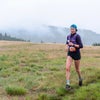New perk! Get after it with local recommendations just for you. Discover nearby events, routes out your door, and hidden gems when you sign up for the Local Running Drop.
Andrew Skurka has covered more backcountry miles by the age of 34 than most people will in a lifetime: His current total is somewhere above 30,000. Skurka, a Massachusetts native who lives in Boulder, Colorado, is a longtime trail runner with a PR of 8 hours 2 minutes for the rugged, 42-mile Grand Canyon Rim-to-Rim-to-Rim run and a second-place finish in the 2008 Leadville 100 to his credit. But his true renown is in his lengthy resume of fastpacking exploits, like following the Appalachian Trail for over 2,100 miles (his first backpacking trip ever) and a 500-mile trek across Iceland.
But what Skurka calls his “coming-of-age hike” was the Sea to Sea (C2C). Over 11 months—August 2004 to July 2005—he traversed North America from Québec to Cape Alava, Washington, traveling 7,778 miles—and hiking straight through the winter.
“I was 22 or 23, and I was taking advantage of the period in between childhood and adulthood,” he says of C2C. It was the time “after you’re finally on your own, but before ‘adult’ responsibilities crimp your style.”
In 2010, he completed his Alaska-Yukon Expedition, covering 4,700 miles of largely trail-less wilderness in 176 days (which earned him a feature and the title of “Adventurer of the Year” in National Geographic).
Skurka takes little with him on his trips. Aside from food and water, his pack typically weighs eight to 10 pounds, and includes a shelter, sleeping bag, clothing, a small stove, maps and first-aid supplies. While widely perceived as one of the world’s best fastpackers, he doesn’t see himself that way. He finds it more sustainable—and enjoyable—to hike at a pace that he can maintain for days on end, focusing on duration rather than speed. When he’s not adventuring on his own or with his wife, Amanda, he occasionally leads guided trips. He speaks at trail clubs and recreation programs and has written a book on backcountry gear.
We asked Skurka: Why backpacking? And how can trail runners get in on the action?
For those who aren’t familiar with it, how do you explain fastpacking?
I would consider it multi-day ultrarunning. But like ultrarunning, it’s a bit of a misnomer—very few people have the fitness to average more than about three miles per hour on multi-day backcountry efforts. That’s not fast; it’s about the pace of an average walk.
Why did backpacking appeal to you over trail running, or other mountain sports?
I’ve always enjoyed the simple lifestyle, the opportunity to be committed for months on end to a single goal, accessing backcountry areas under my own power. In general, I find it much richer than ultrarunning, like the difference between dating and marriage.
You’re going out for a “typical” multi-day trip. What’s in your backpack?
For a multi-day backcountry trip, I’m going to bring a full backpacking kit, albeit a lightweight one. That generally is going to be around 10 pounds before I add food and water, which get heavy quickly. For hard-charging trips, I’m at about 28 ounces of food per day, nearly two pounds. Water is environmentally driven: In wet areas, I can drink as I go. In an arid place, it gets harder to stay adequately hydrated.
What’s your favorite on-the-trail snack?
Peanut butter M&Ms.
For a first-time fastpacker, what’s your most important advice?
Consider hiking instead. It’ll be more enjoyable on multiple levels. Physically it’ll be less jarring, and emotionally it’ll be less fatiguing than to feel like you’re in race mode for multiple days.
Any favorite destinations?
In the Lower 48, the California High Sierras, the Wind River Range in Wyoming and Utah’s Grand Staircase-Escalante National Monument.
How do you “train” for fastpacking?
It involves typical high-volume ultrarunning combined with regular backpacking trips.
You’ve also had some success trail running. How does backpacking help or hinder that, and vice versa?
To a point, they are mutually beneficial. But I think if you want to be at the top of your game, ultimately you need to specialize in your niche. I find that when I’m running well, I’m not as strong of a backpacker. And when I’m backpacking well, I can’t run as fast.
And finally, what do you do when you get home?
Sleep.
This article originally appeared in our September 2016 issue.
